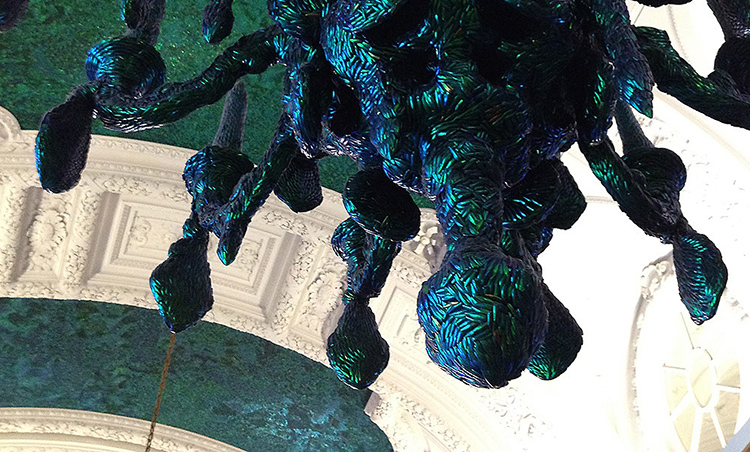The Belgian artist Jan Fabre, born in Antwerp in 1958, is one of the most charismatic characters of the current art scene. A multidisciplinary artist who makes sculptures, designs, prepares choreographies and plays, or makes valued drawings using only the popular BIC pens.
He has been considered the enfant terrible of the Belgian contemporary art as he made assemblies consisting of burning money, or did paintings using his own blood and even his sperm. Not to mention that in some occasion he has been accused of animal abuse for his audiovisual creations. And although the controversy has been with him all this time, nowadays his prestige is enormous and his works are highly prized.
To get an idea of it, it is enough to know two facts. For example, in 2008 he was the first living artist who had a solo exhibition at the Louvre Museum in Paris. And before that, in 2002 he had already done the work that concerns us here, Heaven of Delight, made nothing short than commissioned by Queen Paola inside the Royal Palace of Brussels.
The Royal Palace of Brussels
The Royal Palace of Brussels is situated not too far from the center of the European Union’s capital. Nowadays the Belgian kings do not live here, as they live in the Palace of Laeken, in the north of the city. But the truth is that the Royal Palace is still their workplace, because there are the monarchs’ offices and is the place where official receptions are held to the highest foreign dignitaries.
Due to this official use, for much of the year it only can be seen from the outside, while you walk through its beautiful gardens. Nevertheless, in the summer, the Royal Palace of Brussels opens its doors to the public free of charge.
That is when travelers can enter into the palace’s swanky lounges and dining rooms where there are many works of art. There are countless sculptures, delicate tapestries, period furniture, lavish lamps or first level paintings, including some signed by Francisco de Goya.
In short, a tour around the many treasures accumulated by the Belgian royals over time. A glamorous and amazing itinerary that includes many curiosities. Although one of the biggest surprises arrives when going into the so-called Hall of Mirrors.
The Hall of Mirrors
This hall was unfinished at king’s Leopoldo II death in 1909. It was precisely that monarch who ended a long royal tradition. The tradition was that every king or queen had to invite an artist of the time to do a work in the palace. Something that was not done during the twentieth century, but when we enter the XXI Queen Paola decided to resume the habit.
In fact, she was the one who supported that the controversial Jan Fabre would carry out a unique intervention that would transform the Hall of Mirrors in the Heaven of Delight.
Heaven of Delight
The artist decided to radically change the look of the hall. For that task, he flooded the roof of a bright iridescent green. Paint? No. He used the carcass of approximately half million beetles brought from Southeast Asia, mainly from Thailand.
Fabre has used insects in his works on other occasions, but this time he decided to use the jewel beetle, not only for its color, but also because it is a very abundant species and therefore is not protected. Moreover, in the carcass’s chemical composition we find the chitosan, a substance that according to Fabre prevents losing these shells’ brightness over time.
In the hall, he drew with his usual BIC pen numerous shapes including reptiles’ eyes or bird’s wings and also a huge P, in honor of his patron Queen Paola. These drawings are the pattern that followed his 29 helpers to stick for months the beetles’ carcasses, creating a spectacular print both in the hall’s dome and in one of its lamps.
A luminous pleasure
The result of this intervention caused undoubtedly much expectancy from the start, and over the years is gaining prestige as one of the greatest artistic works of our century.
When walking around the room, initially surprises to think that, although we are in a royal palace, over our heads we find more than a million bugs. It is a peculiar paradox. But after eliminating prejudices and, for the more apprehensive the repulsion, we can enjoy the work.
We appreciate its coloring joining emerald green with iridescent glitter, greenish blue with bluish green, joining metallic violet with gold touches.
A single color, extremely intense and natural knowing its origin. And with all those shades capturing the light to create forms. It was Fabre himself who said that the light it irradiated made it the “heaven of pleasure, of delight.”
Translated by Raquel Sanchez













